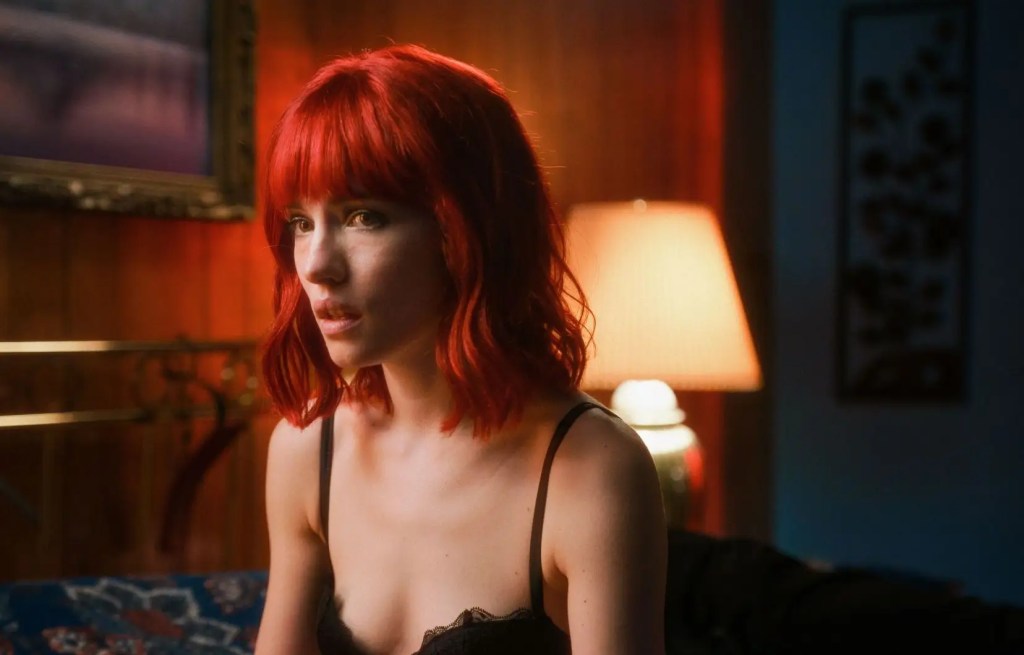Exercises in genre pastiche can go both ways. Quentin Tarantino benefits from utilizing his encyclopedic knowledge of cinema history in a fresh and innovative manner. At the same time, this year’s MaXXXine (2024) displayed Ti West’s inability to untangle style and references without offering a distinct directorial vision. In his sophomore outing, writer/director JT Mollner constructs a horror thriller that transports you back to the 1970s era of simple genre exercises where the plot is thin and sparse. Still, the directorial grasp overwhelms the frame centered on expertly defined performances.
Strange Darling (2024) feels like a breath of fresh air in a summer dominated by sequels, prequels, callback films, and everything in between. Darling is a small film that shines on the smallest screen at your local cinema. The lack of stars and an expensive marketing campaign aid its allure, and word-of-mouth speaks to passion.
Part of the enthusiasm is found in not revealing too much, so I will provide as few details as possible to avoid spoiling the excitement felt throughout the film’s ninety-six-minute runtime. Darling focuses on a wild one-night stand between the Lady (Ella Fitzgerald) and the Demon (Kyle Gallner) in rural Oregon, which descends into a nightmare-induced ordeal. Before a frame is shown, we are treated to an opening crawl calling back to the opening of The Texas Chain Saw Massacre (1974), where Jason Patric narrates in true crime fashion that we’re watching a dramatization of the final days of a prolific serial killer.
The first frame shows Lady running frantically in an open field, fear painted on her face, wearing red scrubs, and sporting a bloodied left ear while Demon chases her through the backwoods with a rifle. Mollner keeps the viewer at a distance, so much so that the film is told in six nonlinear chapters. Each chapter directly announces itself like a disordered fairy tale told by the Brothers Grimm. What begins as an exercise in genre tropes soon transcends its stylistic trappings, with each chapter thrashing our expectations toward notions of consent, communication, and gender dynamics.
That may seem like a lot to digest for a simple chase narrative; part of the fun is giving yourself to Mollner’s hands and allowing yourself to feel uncomfortable and unnerved by how much the narrative changes. Each chapter is uneasy; the film knows when to reveal its hand and upends preconceived notions of the horror genre.
Mollner strings together each chapter to engage and envelop the viewer in a tense and deranged nightmare where what seems simple slowly unravels into a dense commentary. The film examines how far consent pushes the boundaries of participating people and how communication plays a part in dominant and submissive power dynamics. Lady remarks how vulnerable of a position she’s placed in by choosing to spend the night with Demon, hinting at a fear that feels both universal and specific to those interested in sexual exploration through role-playing and inverse gender dynamics.
Mollner encloses the viewer into key specific locations, making the walls feel as if they are trapping the characters and viewer. The outside world is distant, and the action is isolated. Many scenes play out in extended one-takes where the images feel like an extended dream that transitions into a horror show you can’t awake from.
Noted character actor Giovanni Ribisi makes his behind-the-camera debut as the film’s cinematographer, and it’s a phenomenal showcase. His work is reminiscent of the look and feel of 1970s grindhouse films, where the colors are heightened and the images look vibrant and grainy. When blood hits the screen it feels heavy and potent. The neon-lit motel room where Lady and Demon spend their night feels otherworldly and unearthly, where two souls feel alone from the outside world.

The performances of Fitzgerlad and Gallner are staggering. The delicate line they have to walk is immense, yet both dance around each other like ballet dancers. Neither character is honest, hiding significant details about each other. Yet their initial flirtatious connection is genuine and palpable. The sexual brazenness of Lady in exploring physical boundaries and communicating desires compliments the coyness of Demon’s desires.
Fitzgerald’s star-making performance is transformative and thrilling; she commands the screen as she actualizes her fantasy while controlling a situation where she could be helpless (one of her fantasies includes being in handcuffs). Each chapter signifies an emotional shift from how Lady processes a one-night stand into a fight for survival, as she finds herself fleeing for her life and hiding from a man hellbent on killing her. The way Fitzgerlad morphs and shifts her body language is on par with some of the best Final Girl performances in the horror genre. Her wide-eyed look of intense fear countered by her lanky figurine and blood-splattered face creates an indelible image.
Gallner is equally compelling as an intimidating and relentless killer. There’s a natural softness to his initial demeanor that makes him charming and innocent, yet he slowly unravels that veneer into a crazed killing machine. It’s a tricky performance that swerves in unique directions, and you never have a concrete grasp of his intentions. Gallner excels at being creepy and exciting with more subdued layers waiting to be revealed. The additional supporting cast, such as Barbara Hershey and Ed Begley Jr as two hippie doomsday preppers giving refuge to Lady in her escape, bring a necessary touch of levity to this taut thriller, especially in a sequence where they pile their breakfast plates with every possible breakfast item one can imagine.
Mollner is not groundbreaking in presenting a story that feels fresh and unique through visual flourishes; Strange Darling sucker-punches you the same way Barbarian (2022) plays into your preconceptions of the horror genre. In a sea of films that feel safe, made by committee, and set up to make millions of dollars, the oddity of this bizarre genre-bending film is a testament to indie filmmaking and to the talents of Mollner, Fitzgerald, Gallner, Ribisi, and everyone involved.
That a team with one-one hundredth of most budgets produces a fully-formed, exhilarating, and fresh film is remarkable. Strange Darling doesn’t just call back to an era of antiquated cinema; it implements those aesthetics in a package that subverts preconceptions and, by the end, left me with a euphoric high that so few films this summer have left me feeling.
Review Courtesy of Amritpal Rai
Feature Image Credit to Mirama via Indiewire

Recent Comments